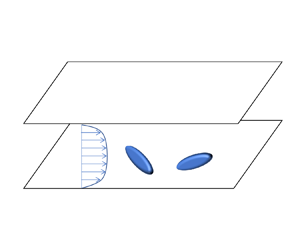Published online by Cambridge University Press: 14 December 2023

Rotation and orientation of non-spherical particles in a fluid flow depend on the hydrodynamic torque they experience. However, little is known about the effect of the fluid inertial torque on the dynamics of tiny inertial spheroids in turbulent channel flows, as only Jeffery torque has been considered in previous studies by point-particle direct numerical simulations. In this study, we investigate the rotation and orientation of tiny spheroids with both fluid inertial torque and Jeffery torque in a turbulent channel flow. By comparing with the case in the absence of fluid inertial torque, we find that the rotational and orientational dynamics of spheroids is significantly affected by the fluid inertial torque when the Stokes number, which is non-dimensionalized by fluid viscous time scale, is larger than the critical value  $St_c\approx 2$, indicating that the fluid inertial torque is non-negligible for most particle cases considered in earlier studies. In contrast to the earlier findings considering only Jeffery torque (Challabotla et al., J. Fluid Mech., vol. 776, 2015, p. R2), we find that prolate (oblate) spheroids with a large Stokes number tend to tumble (spin) in the streamwise–wall-normal plane in a thinner region near the wall due to the presence of the fluid inertial torque. Approaching the channel centre, the flow shear gradually vanishes, but the velocity difference between local fluid and particles is still pronounced and increasing as particle inertia grows. As a result, in the core region, fluid inertial torque is dominant and drives the particles to align with its broad side normal to the streamwise direction rather than a random orientation observed in earlier studies without fluid inertial torque. Meanwhile, the presence of fluid inertial torque enhances the tumbling rates of spheroids in the core region. In addition, the effect of fluid inertial force on the dynamics of spheroids is also examined in this study, but the results indicate the effect of fluid inertial force is weak. Our findings imply the importance of fluid inertial torque in modelling the dynamics of inertial non-spherical particles in turbulent channel flows.
$St_c\approx 2$, indicating that the fluid inertial torque is non-negligible for most particle cases considered in earlier studies. In contrast to the earlier findings considering only Jeffery torque (Challabotla et al., J. Fluid Mech., vol. 776, 2015, p. R2), we find that prolate (oblate) spheroids with a large Stokes number tend to tumble (spin) in the streamwise–wall-normal plane in a thinner region near the wall due to the presence of the fluid inertial torque. Approaching the channel centre, the flow shear gradually vanishes, but the velocity difference between local fluid and particles is still pronounced and increasing as particle inertia grows. As a result, in the core region, fluid inertial torque is dominant and drives the particles to align with its broad side normal to the streamwise direction rather than a random orientation observed in earlier studies without fluid inertial torque. Meanwhile, the presence of fluid inertial torque enhances the tumbling rates of spheroids in the core region. In addition, the effect of fluid inertial force on the dynamics of spheroids is also examined in this study, but the results indicate the effect of fluid inertial force is weak. Our findings imply the importance of fluid inertial torque in modelling the dynamics of inertial non-spherical particles in turbulent channel flows.